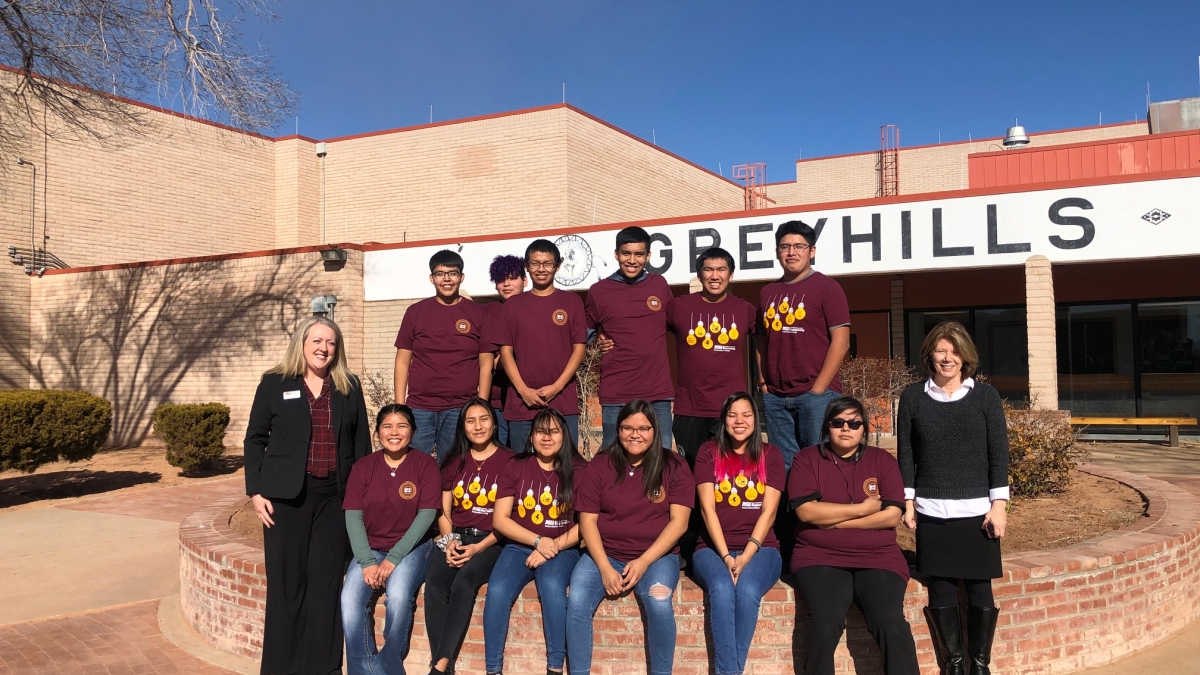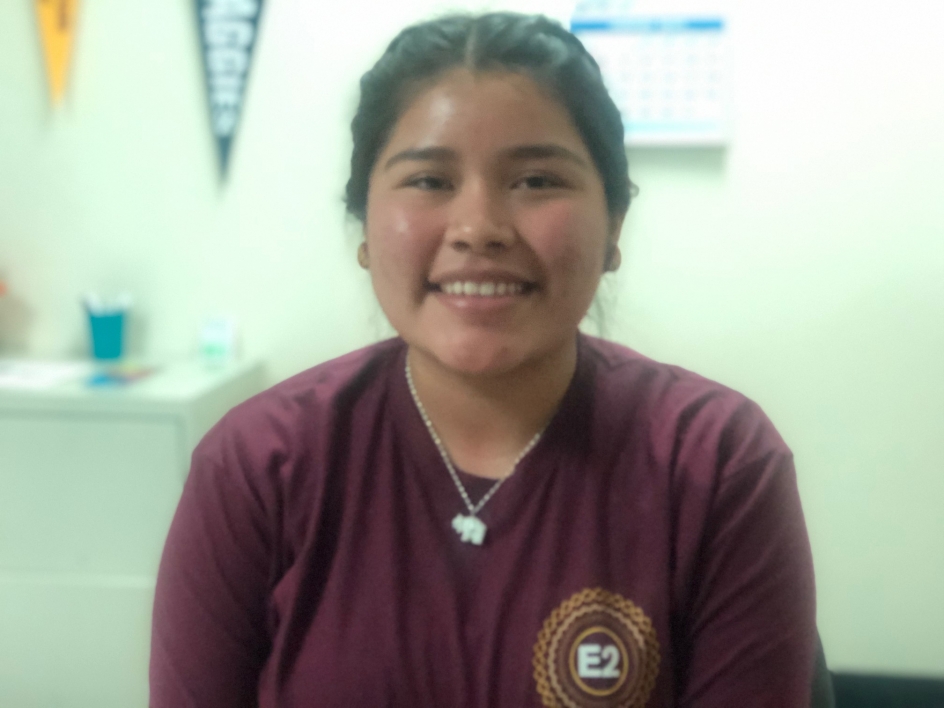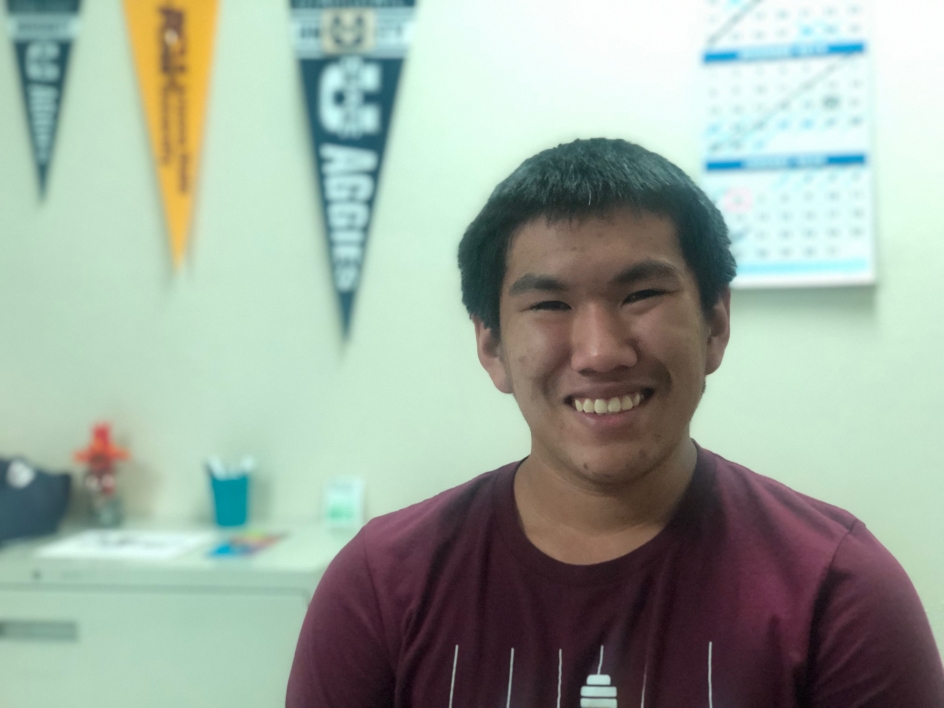New partnership brings ASU Prep Digital engineering course to Navajo Nation teens

Mary O'Malley (far left), ASU Prep Digital director of Arizona collaboratives, stands with with the Greyhills student cohort and Dana Van Deinse (far right), ASU Prep Digital executive director.
Ashley Huskie, 17, has time to think on her hour-and-a-half bus ride to and from school. She makes the trip once a week so she can attend Greyhills Academy High School in Tuba City, Arizona, where she boards in the dormitory during the week and travels home, deeper in the Navajo Nation, on the weekends. She introduces herself with her clan names to honor where she’s from: Deer Spring People Clan, Towering House Clan, Edgewater People’s Clan and Bitter Water People’s Clan.
A senior at Greyhills, Huskie is working toward a future in organic architecture inspired by her connection to her home and respect for the environment.
“Where I grew up, most of us, we have homes, yeah, but they’re mobile homes. Or some are regular homes, and they don’t seem to last long. People just leave them,” she said. “They don’t decay in the right way. They cause health issues … and no one can live there and the house just sits there.”
Since the seventh grade, Huskie has been interested in changing the way architecture and home building is approached, for public and environmental health.
She is already working toward her future in organic architecture by learning in her own community; she’s one of 12 students at Greyhills who are taking an introduction to engineering course on their Tuba City campus thanks to a new partnership the school has with ASU Prep Digital.
The cohort of juniors and seniors are taking Engineering 100 together in an initiative that allows students to start earning college credit, get exposed to relevant local career skills and access a huge catalog of coursework. The coursework blends live video sessions, online modules, hands-on project building and more.
Ashley Huskie
There are more than 75 Arizona schools partnering with ASU Prep Digital, but Greyhills is the first tribal partnership and also the first partnership in northern Arizona. The collaboration was born out of a need that the principal voiced: to build a pipeline of educators and amplify college prep options that are accessible for Tuba City students, who sometimes face transportation and financial barriers in accessing higher education.
Greyhills Principal Loren Hudson said the cohort of students are critical thinkers who are hungry for knowledge and appreciate the opportunity to have ASU courses brought to them.
“This opportunity is very significant. It allows for students to continue to take college courses that are not normally offered by dual enrollment,” he said. “I believe that it also allows for more rigor and relevance to the types of classes they are interested in and gets them more experience in the college setting.”
Native American students tend to be underrepresented on college campuses. According to the State of Indian Country Arizona Volume 1 report, 3.5% of people on Arizona reservations have earned a bachelor’s degree or higher. Mining, construction and health care are some of the biggest employment opportunities in northeastern Arizona.
Opening more pathways to higher education was a key motivator in moving the collaboration forward. Mary O’Malley, director of Arizona collaboratives at ASU Prep Digital, said the partnership is a testament to Greyhills Academy’s dedication to their students.
“It’s about relationship building and building innovative models that focus on student success and increase levels of achievement,” said O’Malley. “It’s exciting to see the students begin their studies.”
The cohort of students chose the engineering topic together; they started their coursework in January and will finish in April. Huskie, who will be the first person in her family to graduate from high school on time, said she was excited to take an engineering course because it will expose her to online classes and science and math. She plans to work in carpentry and take online courses after she graduates and then pursue a four-year degree in architecture.
“I want to start a new trend to have organic homes that can decay in a good way but also can be up for a long while,” she said. “And I want to be there for my siblings and show them that if I can do, it it’s possible for anyone else to do it and even for them.”
Tillman Claw
Tillman Claw, 17, is another senior in the ASU Prep Digital cohort. He said he loves the engineering class because it allows him to harness his interest in creating and building.
“What I’ve liked most about it is that it brings out the creativity in the students. For me, I get to create stuff with my hands because I’m a hands-on person,” he said.
He said the pace of the course and the peer-to-peer help has made for a collaborative and supportive environment. His favorite part of the class so far was when students had to build a tower out of tissue paper to see how they could make it stand.
After graduation, Claw plans on working and doing general studies for a year before going on a religious mission trip and then going to school for engineering. He has always loved to build and grew up watching and learning carpentry from his dad. Claw said the engineering coursework was a great preview of what’s ahead in college.
“I wanted to see how the college class was … and be able to build on that if I keep going in engineering,” he said.
The introduction to engineering course is one of about 200 college courses that ASU Prep Digital offers students that go beyond dual enrollment and Advanced Placement. Though any student anywhere in the world can be enrolled in ASU Prep Digital, school partnerships offer greatly reduced tuition, typically about a 30% to 50% savings, for resources that complement what is offered at students’ schools of record.
O’Malley emphasized that schools’ state funding is not affected by partnering with ASU Prep Digital. Typically either families, schools or districts pay for tuition or curriculum licensing. In the case of Greyhills, the school made the investment so that students could access the coursework at the high school at no cost.
“They’re really investing in their students, and they see the potential and the importance of this opportunity for the kids,” said O’Malley. “Dr. Hudson has worked closely with parents, his school board and the community, and they all really support his vision.”
O’Malley said that no two ASU Prep Digital partnerships with Arizona schools are alike because the offerings are tailored to what schools need. In Eloy, a partnership helped provide Spanish teachers when the district had a shortage; in Maryvale, ASU Prep Digital provided a rigorous algebra option for gifted seventh and eighth graders; in Miami, a partnership offered a new blended-learning option and teacher training to bolster student resources and outcomes. She said that the partnership may continue after the spring semester, but for now everyone is just happy to see the opportunities at work.
Hudson, who grew up on the Navajo Reservation with his parents and grandparents, attended school in Tuba City. He earned his bachelor’s degree, master’s degree and doctorate at Northern Arizona University, and he said it means a great deal to him to promote higher education at Greyhills.
“We believe that postsecondary opportunities being offered to students here will open new doors for them and their families — and indirectly our community,” he said.
At Greyhills, Hudson said they believe that cooperation is key to furthering education and that he’s thankful to ASU Prep Digital and Arizona State University for the collaboration.
“It will take a concerted effort to improve things and issues in our society that we share. We also believe that it is through educating our youth and empowering our communities that we can grow in this positive direction,” said Hudson.
More Science and technology

ASU postdoctoral researcher leads initiative to support graduate student mental health
Olivia Davis had firsthand experience with anxiety and OCD before she entered grad school. Then, during the pandemic and as a…

ASU graduate student researching interplay between family dynamics, ADHD
The symptoms of attention deficit hyperactivity disorder (ADHD) — which include daydreaming, making careless mistakes or taking…

Will this antibiotic work? ASU scientists develop rapid bacterial tests
Bacteria multiply at an astonishing rate, sometimes doubling in number in under four minutes. Imagine a doctor faced with a…

